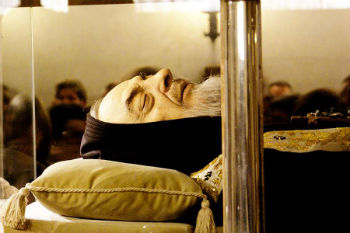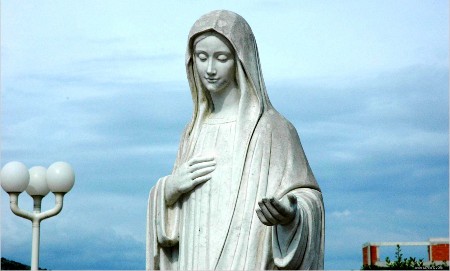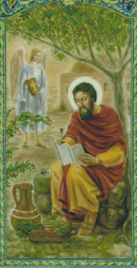We ask you, humbly: don't scroll away.
Hi readers, it seems you use Catholic Online a lot; that's great! It's a little awkward to ask, but we need your help. If you have already donated, we sincerely thank you. We're not salespeople, but we depend on donations averaging $14.76 and fewer than 1% of readers give. If you donate just $5.00, the price of your coffee, Catholic Online School could keep thriving. Thank you.Help Now >
St. Polycarp
FREE Catholic Classes
Martyr (A.D. 69-155).
Our chief sources of information concerning St. Polycarp are: (1) the Epistles of St. Ignatius; (2) St. Polycarp's own Epistle to the Philippians ; (3) sundry passages in St. Irenæus ; (4) the Letter of the Smyrnaeans recounting the martyrdom of St. Polycarp.
The Epistles of St. Ignatius
Four out of the seven genuine epistles of St. Ignatius were written from Smyrna. In two of these -- Magnesians and Ephesians -- he speaks of Polycarp. The seventh Epistle was addressed to Polycarp. It contains little or nothing of historical interest in connexion with St. Polycarp. In the opening words St. Ignatius gives glory to God "that it hath been vouchsafed to me to see thy face". It seems hardly safe to infer, with Pearson and Lightfoot, from these words that the two had never met before.
The Epistle of St. Polycarp to the Philippians
The Epistle of St. Polycarp was a reply to one from the Philippians, in which they had asked St. Polycarp to address them some words of exhortation; to forward by his own messenger a letter addressed by them to the Church of Antioch ; and to send them any epistles of St. Ignatius which he might have. The second request should be noted. St. Ignatius had asked the Churches of Smyrna and Philadelphia to send a messenger to congratulate the Church of Antioch on the restoration of peace; presumably, therefore, when at Philippi, he gave similar instructions to the Philippians. This is one of the many respects in which there is such complete harmony between the situations revealed in the Epistles of St. Ignatius and the Epistle of St. Polycarp, that it is hardly possible to impugn the genuineness of the former without in some way trying to destroy the credit of the latter, which happens to be one of the best attested documents of antiquity. In consequence some extremists, anti-episcopalians in the seventeenth century, and members of the Tübingen School in the nineteenth, boldly rejected the Epistle of Polycarp. Others tried to make out that the passages which told most in favour of the Ignatian epistles were interpolations.
These theories possess no interest now that the genuineness of the Ignatian epistles has practically ceased to be questioned. The only point raised which had any show of plausibility (it was sometimes used against the genuineness, and sometimes against the early date of St. Polycarp's Epistle) was based on a passage in which it might at first sight seem that Marcion was denounced : "For every one who does not confess that Jesus Christ has come in the flesh is antichrist ; and whosoever does not confess the testimony of the cross, is a devil, and whosoever perverteth the oracles of the Lord (to serve) his own lusts, and saith there is neither resurrection nor judgment, this man is a first-born of Satan." St. Polycarp wrote his epistle before he had heard of St. Ignatius' martyrdom. Now, supposing the passage just quoted to have been aimed at Marcion (whom, on one occasion, as we shall presently see, St. Polycarp called to his face "the first-born of Satan "), the choice lies between rejecting the epistle as spurious on account of the anachronism, or bringing down its date, and the date of St. Ignatius' martyrdom to A.D. 130-140 when Marcion was prominent. Harnack seems at one time to have adopted the latter alternative; but he now admits that there need be no reference to Marcion at all in the passage in question (Chronologie, I, 387-8). Lightfoot thought a negative could be proved. Marcion, according to him, cannot be referred to because nothing is said about his characteristic errors, e.g., the distinction between the God of the Old and the God of the New Testament ; and because the antinomianism ascribed to "the first-born of Satan " is inapplicable to the austere Marcion (Lightfoot, St. Ignatius and St. Polycarp, I, 585; all references to Lightfoot (L), unless otherwise stated, will be to this work).
When Lightfoot wrote it was necessary to vindicate the authenticity of the Ignatian epistles and that of St. Polycarp. If the former were forgeries, the latter, which supports -- it might almost be said presupposes -- them, must be a forgery from the same hand. But a comparison between Ignatius and Polycarp shows that this is an impossible hypothesis. The former lays every stress upon episcopacy, the latter does not even mention it. The former is full of emphatic declarations of the doctrine of the Incarnation, the two natures of Christ, etc. In the latter these matters are hardly touched upon. "The divergence between the two writers as regards Scriptural quotations is equally remarkable. Though the seven Ignatian letters are many times longer than Polycarp's Epistle, the quotations in the latter are incomparably more numerous, as well as more precise, than in the former. The obligations to the New Testament are wholly different in character in the two cases. The Ignatian letters do, indeed, show a considerable knowledge of the writings included in our Canon of the New Testament ; but this knowledge betrays itself in casual words and phrases, stray metaphors, epigrammatic adaptations, and isolated coincidences of thought ... On the other hand in Polycarp's Epistle sentence after sentence is frequently made up of passages from the Evangelical and Apostolic writings ... But this divergence forms only part of a broader and still more decisive contrast, affecting the whole style and character of the two writings. The profuseness of quotations in Polycarp's Epistle arises from a want of originality ... On the other hand the letters of Ignatius have a marked individuality. Of all early Christian writings they are pre-eminent in this respect" (op.cit., 595-97).
Various passages in St. Irenaeus
In St. Irenæus, Polycarp comes before us preeminently as a link with the past. Irenaeus mentions him four times: (a) in connection with Papias; (b) in his letter to Florinus; (c) in his letter to Pope Victor ; (d) at the end of the celebrated appeal to the potior principalitas of the Roman Church.
In connection with Papias
From "Adv. Haer.", V, xxxiii, we learn that Papias was "a hearer of John, and a companion of Polycarp".
In his letter to Florinus
Florinus was a Roman presbyter who lapsed into heresy. St. Irenæus wrote him a letter of remonstrance (a long extract from which is preserved by Eusebius, II, E., V,xx), in which he recalled their common recollections of Polycarp. "These opinions ... Florinus are not of sound judgment ... I saw thee when I was still a boy in Lower Asia in company with Polycarp, while thou wast faring prosperously in the royal court, and endeavouring to stand well with him. For I distinctly remember the incidents of that time better than events of recent occurrence ... I can describe the very place in which the Blessed Polycarp used to sit when he discoursed ... his personal appearance ... and how he would describe his intercourse with John and with the rest who had seen the Lord, and how he would relate their words ... I can testify in the sight of God, that if the blessed and apostolic elder had heard anything of this kind, he would have cried out, and stopped his ears, and said after his wont, 'O good God, for what times hast thou kept me that I should endure such things?' ... This can be shown from the letters which he wrote to the neighbouring Churches for their confirmation etc.". Lightfoot (op.cit., 448) will not fix the date of the time when St. Irenæus and Florinus were fellow-pupils of St. Polycarp more definitely than somewhere between 135 and 150. There are in fact no data to go upon.
In his letter to Pope Victor
The visit of St. Polycarp to Rome is described by St. Irenæus in a letter to Pope Victor written under the following circumstances. The Asiatic Christians differed from the rest of the Church in their manner of observing Easter. While the other Churches kept the feast on a Sunday, the Asiatics celebrated it on the 14th of Nisan, whatever day of the week this might fall on. Pope Victor tried to establish uniformity, and when the Asiatic Churches refused to comply, excommunicated them. St. Irenæus remonstrated with him in a letter, part of which is preserved by Eusebius (H. E., V, xxiv), in which he particularly contrasted the moderation displayed in regard to Polycarp by Pope Anicetus with the conduct of Victor. "Among these (Victor's predecessors) were the presbyters before Soter. They neither observed it (14th Nisan) themselves, nor did they permit those after them to do so. And yet, though not observing it, they were none the less at peace with those who came to them from the parishes in which it was observed. ... And when the blessed Polycarp was at Rome in the time of Anicetus, and they disagreed a little about other things, they immediately made peace with one another, not caring to quarrel over this matter. For neither could Anicetus persuade Polycarp ... nor Polycarp Anicetus... . But though matters were in this shape, they communed together, and Anicetus conceded the administration of the Eucharist in the Church to Polycarp, manifestly as a mark of respect. And they parted from each other in peace", etc.
There is a difficulty connected with this visit of Polycarp to Rome. According to the Chronicle of Eusebius in St. Jerome's version (the Armenian version is quite untrustworthy) the date of Anicetus' accession was A.D. 156-57. Now the probable date of St. Polycarp's martyrdom is February, 155. The fact of the visit to Rome is too well attested to be called into question. We must, therefore, either give up the date of martyrdom, or suppose that Eusebius post-dated by a year or two the accession of Anicetus. There is nothing unreasonable in this latter hypothesis, in view of the uncertainty which so generally prevails in chronological matters (for the date of the accession of Anicetus see Lightfoot, "St. Clement I", 343).
In his famous passage on the Roman Church
We now come to the passage in St. Irenæus (Adv. Haer., III,3) which brings out in fullest relief St. Polycarp's position as a link with the past. Just as St. John's long life lengthened out the Apostolic Age, so did the four score and six years of Polycarp extend the sub-Apostolic Age, during which it was possible to learn by word of mouth what the Apostles taught from those who had been their hearers. In Rome the Apostolic Age ended about A.D. 67 with the martyrdom of St. Peter and St. Paul, and the sub-Apostolic Age about a quarter of a century later when St. Clement, "who had seen the blessed Apostles ", died. In Asia the Apostolic Age lingered on till St. John died about A.D. 100; and the sub-Apostolic Age till 155, when St. Polycarp was martyred. In the third book of his treatise "Against Heresies", St. Irenæus makes his celebrated appeal to the "successions" of the bishops in all the Churches. He is arguing against heretics who professed to have a kind of esoteric tradition derived from the Apostles. To whom, demands St. Irenæus, would the Apostles be more likely to commit hidden mysteries than to the bishops to whom they entrusted their churches? In order then to know what the Apostles taught, we must have recourse to the "successions" of bishops throughout the world. But as time and space would fail if we tried to enumerate them all one by one, let the Roman Church speak for the rest. Their agreement with her is a manifest fact by reason of the position which she holds among them ("for with this Church on account of its potior principalitas the whole Church, that is, the faithful from every quarter, must needs agree", etc.).
Then follows the list of the Roman bishops down to Eleutherius, the twelfth from the Apostles, the ninth from Clement, "who had both seen and conversed with the blessed Apostles ". From the Roman Church, representing all the churches, the writer then passes on to two Churches, that of Smyrna, in which, in the person of Polycarp, the sub-Apostolic Age had been carried down to a time still within living memory, and the Church of Ephesus, where, in the person of St. John, the Apostolic Age had been prolonged till "the time of Trajan ". Of Polycarp he says, "he was not only taught by the Apostles, and lived in familiar intercourse with many that had seen Christ, but also received his appointment in Asia from the Apostles as Bishop in the Church of Smyrna ". He then goes on to speak of his own personal acquaintance with Polycarp, his martyrdom, and his visit to Rome, where he converted many heretics. He then continues, "there are those who heard him tell how John, the disciple of the Lord, when he went to take a bath in Ephesus, and saw Cerinthus within, rushed away from the room without bathing, with the words 'Let us flee lest the room should fall in, for Cerinthus, the enemy of the truth, is within'. Yea, and Polycarp himself, also, when on one occasion Marcion confronted him and said 'Recognise us', replied, 'Ay, ay, I recognise the first-born of Satan ' ".
The Smyrnaean letter describing St. Polycarp's martyrdom
Polycarp's martyrdom is described in a letter from the Church of Smyrna, to the Church of Philomelium "and to all the brotherhoods of the holy and universal Church ", etc. The letter begins with an account of the persecution and the heroism of the martyrs. Conspicuous among them was one Germanicus, who encouraged the rest, and when exposed to the wild beasts, incited them to slay him. His death stirred the fury of the multitude, and the cry was raised "Away with the atheists ; let search be made for Polycarp". But there was one Quintus, who of his own accord had given himself up to the persecutors. When he saw the wild beasts he lost heart and apostatized. "Wherefore", comment the writers of the epistle, "we praise not those who deliver themselves up, since the Gospel does not so teach us". Polycarp was persuaded by his friends to leave the city and conceal himself in a farm-house. Here he spent his time in prayer, "and while praying he falleth into a trance three days before his apprehension; and he saw his pillow burning with fire. And he turned and said unto those that were with him, 'it must needs be that I shall be burned alive'". When his pursuers were on his track he went to another farm-house. Finding him gone they put two slave boys to the torture, and one of them betrayed his place of concealment. Herod, head of the police, sent a body of men to arrest him on Friday evening. Escape was still possible, but the old man refused to flee, saying, "the will of God be done". He came down to meet his pursuers, conversed affably with them, and ordered food to be set before them. While they were eating he prayed, "remembering all, high and low, who at any time had come in his way, and the Catholic Church throughout the world". Then he was led away.
Herod and Herod's father, Nicetas, met him and took him into their carriage, where they tried to prevail upon him to save his life. Finding they could not persuade him, they pushed him out of the carriage with such haste that he bruised his shin. He followed on foot till they came to the Stadium, where a great crowd had assembled, having heard the news of his apprehension. "As Polycarp entered into the Stadium a voice came to him from heaven : 'Be strong, Polycarp, and play the man'. And no one saw the speaker, but those of our people who were present heard the voice." It was to the proconsul, when he urged him to curse Christ, that Polycarp made his celebrated reply: "Fourscore and six years have I served Him, and he has done me no harm. How then can I curse my King that saved me." When the proconsul had done with the prisoner it was too late to throw him to the beasts, for the sports were closed. It was decided, therefore, to burn him alive. The crowd took it upon itself to collect fuel, "the Jews more especially assisting in this with zeal, as is their wont" (cf. the Martyrdom of Pionius). The fire, "like the sail of a vessel filled by the wind, made a wall round the body" of the martyr, leaving it unscathed. The executioner was ordered to stab him, thereupon, "there came forth a quantity of blood so that it extinguished the fire". (The story of the dove issuing from the body probably arose out of a textual corruption. See Lightfoot, Funk, Zahn. It may also have been an interpolation by the pseudo-Pionius.)
The officials, urged thereto by the Jews, burned the body lest the Christians "should abandon the worship of the Crucified One, and begin to worship this man ". The bones of the martyr were collected by the Christians, and interred in a suitable place. "Now the blessed Polycarp was martyred on the second day of the month of Kanthicus, on the seventh day before the Kalends of March, on a great Sabbath at the eighth hour. He was apprehended by Herodes ... in the proconsulship of Statius Quadratus etc." This subscription gives the following facts: the martyrdom took place on a Saturday which fell on 23 February. Now there are two possible years for this, 155 and 166. The choice depends upon which of the two Quadratus was proconsul of Asia. By means of the chronological data supplied by the rhetorician Aelius Aristides in certain autobiographical details which he furnishes, Waddington who is followed by Lightfoot ("St. Ignatius and St. Polycarp", I, 646 sq.), arrived at the conclusion that Quadratus was proconsul in 154-55 (the proconsul's year of office began in May). Schmid, a full account of whose system will be found in Harnack's "Chronologie", arguing from the same data, came to the conclusion that Quadratus' proconsulship fell in 165-66.
For some time it seemed as if Schmid's system was likely to prevail, but it has failed on two points:
- Aristides tells us that he was born when Jupiter was in Leo. This happened both in 117 and 129. Schmid's system requires the later of these two dates, but the date has been found to be impossible. Aristides was fifty-three years and six months old when a certain Macrinus was governor of Asia. "Now Egger (in the Austrian 'Jahreshefte', Nov., 1906) has published an inscription recording the career of Macrinus, which was erected to him while he was governing Asia, and he pointed out that as the birth of Aristides was either in 117 or 129, the government of Macrinus must have been either in 170-171, or 182-183, and he has shown that the later date is impossible". (Ramsay in "The Expository Times", Jan., 1907.)
- Aristides mentions a Julianus who was proconsul of Asia nine years before Quadratus. Now there was a Claudius Julianus, who is proved by epigraphic and numismatic evidence to have been proconsul of Asia in 145. Schmid produced a Salvius Julianus who was consul in 148 and might, therefore, have been the Proconsul of Asia named by Aristides. But an inscription discovered in Africa giving the whole career of Salvius Julianus disposes of Schmid's hypothesis. The result of the new evidence is that Salvius Julianus never governed Asia, for he was proconsul of Africa, and it was not permitted that the same person should hold both of these high offices. The rule is well known; and the objection is final and insurmountable (Ramsay, "Expos. Times", Feb., 1904. Ramsay refers to an article by Mommsen, "Savigny Zeitschrift fur Rechtgeschichte", xxiii, 54). Schmid's system, therefore, disappears, and Waddington's, in spite of some very real difficulties (Quadratus' proconsulship shows a tendency to slip a year out of place), is in possession. The possibility of course remains that the subscription was tampered with by a later hand. But 155 must be approximately correct if St. Polycarp was appointed bishop by St. John.
There is a life of St. Polycarp by pseudo-Pionius, compiled probably in the middle of the fourth century. It is "altogether valueless as a contribution to our knowledge of Polycarp. It does not, so far as we know, rest on any tradition, early or late, and may probably be regarded as a fiction of the author's own brain" (Lightfoot, op.cit., iii, 431). The postscript to the letter to the Smyrneans: "This account Gaius copied from the papers of Irenaeus... and I, Socrates, wrote it down in Corinth... and I, Pionius again wrote it down", etc. probably came from the pseudo-Pionius. The very copious extracts from the Letter of the Smyrneans given by Eusebius are a guarantee of the fidelity of the text in the manuscripts that have come down.
Join the Movement
When you sign up below, you don't just join an email list - you're joining an entire movement for Free world class Catholic education.
-

-
Mysteries of the Rosary
-
St. Faustina Kowalska
-
Litany of the Blessed Virgin Mary
-
Saint of the Day for Wednesday, Oct 4th, 2023
-
Popular Saints
-
St. Francis of Assisi
-
Bible
-
Female / Women Saints
-
7 Morning Prayers you need to get your day started with God
-
Litany of the Blessed Virgin Mary
Padre Pio overcame suffering with hope, says Italian journalist
-

Bringing Faith to the Big Screen: Brenda Lorena Garcia's Mission in Hollywood
-

The Vatican's Stance on Medjugorje
-
America's Agricultural Shift: How the U.S. Is Becoming a Net Food Importer
-
Pope Francis Encourages Youth to Follow Blessed Carlo Acutis' Devotion to the Eucharist
Daily Catholic
 Daily Readings for Saturday, September 21, 2024
Daily Readings for Saturday, September 21, 2024 St. Matthew: Saint of the Day for Saturday, September 21, 2024
St. Matthew: Saint of the Day for Saturday, September 21, 2024 Nuptial Blessing, Longer: Prayer of the Day for Saturday, September 21, 2024
Nuptial Blessing, Longer: Prayer of the Day for Saturday, September 21, 2024- Daily Readings for Friday, September 20, 2024
- Sts. Andrew Kim Taegon, Paul Chong Hasang, and Companions: Saint of the Day for Friday, September 20, 2024
- In Time of Danger: Prayer of the Day for Friday, September 20, 2024
![]()
Copyright 2024 Catholic Online. All materials contained on this site, whether written, audible or visual are the exclusive property of Catholic Online and are protected under U.S. and International copyright laws, © Copyright 2024 Catholic Online. Any unauthorized use, without prior written consent of Catholic Online is strictly forbidden and prohibited.
Catholic Online is a Project of Your Catholic Voice Foundation, a Not-for-Profit Corporation. Your Catholic Voice Foundation has been granted a recognition of tax exemption under Section 501(c)(3) of the Internal Revenue Code. Federal Tax Identification Number: 81-0596847. Your gift is tax-deductible as allowed by law.












 Daily Readings for Saturday, September 21, 2024
Daily Readings for Saturday, September 21, 2024 St. Matthew: Saint of the Day for Saturday, September 21, 2024
St. Matthew: Saint of the Day for Saturday, September 21, 2024 Nuptial Blessing, Longer: Prayer of the Day for Saturday, September 21, 2024
Nuptial Blessing, Longer: Prayer of the Day for Saturday, September 21, 2024

